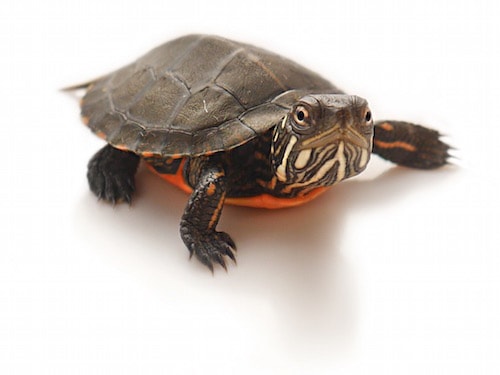
Painted turtles in the wild are opportunistic eaters and will consume anything they come across, such as snails, frogs, slugs, crayfish, fish or insects.
Captive turtles should be fed at least every other day. A diet rich in the right vitamins will ensure their wellbeing and fitness; avoid feeding iceberg lettuce or vegetables high in oxalates as these may interfere with calcium absorption.
Contents
Vegetables
Painted turtles are omnivorous animals that consume an array of foods in the wild. If they can catch it, these turtles eat fish, tadpoles and worms; otherwise they scavenge for carrion and vegetables as a food source.
Painted turtles in captivity should be fed a variety of plant-based and vegetarian-based food sources, including insects and meat products; it’s important not to overfeed them though as overeating could pose health problems.
Your turtle should receive a diet consisting of pellets, fresh fruits and vegetables, live or dried insects such as crickets for optimal growth. This will provide them with all of the essential vitamins and nutrients for healthful development.
Feed your painted turtle a variety of fruits. Just be mindful not to feed citrus fruit that might cause stomach upsets and anything with high potassium content; typically offering only one or two different fruit per day should keep its diet diverse and interesting for your painted turtle.
Fruits
Painted turtles are known for being omnivorous eaters, eating any and all foods available – including fruits and vegetables. As treats they enjoy apples, berries and melons as treats; however they should steer clear of citrus fruit with high potassium levels due to citric acid disrupting their stomachs while too much potassium could damage their shells.
Romaine lettuce, red leaf lettuce, collard greens, kale, mustard greens and squash are among the top choices when feeding painted turtles. Dandelions and parsley may also be included if they do not contain high levels of oxalates that interfere with calcium absorption.
Baby painted turtles need protein in order to develop and thrive. Baby turtles should be fed dried crickets, fish or worms in moderation as this could lead to obesity and metabolic bone disease in adult turtles. Adults should only receive food every two or three days; this mimics their natural diet more accurately while preventing overfeeding or starvation.
Insects
Wild painted turtles supplement their diets with plants but are predominantly carnivorous, eating small fish, crayfish, aquatic insects and carrion for sustenance. Young painted turtles in particular rely heavily on meat sources to fuel growth.
Captive turtles should be fed several times daily. While this may seem excessive, keep in mind that turtles can only digest so much protein at one time; an excess can lead to weight gain and other health issues.
Your pet painted turtle needs more than fresh vegetables and plants for proper nutrition; in addition to dried insects such as crickets, mealworms and waxworms as well as cooked eggs. Citric or potassium-rich fruits such as citrus can irritate their stomachs and lead to calcium deficiency if given too often – these should only make up part of its diet; customized pellets for painted turtles offer high quality sources of protein as an additional food option.
Meat
Painted turtles are adaptable creatures and will eat anything available to them in their environment, such as small fish, crabs or snails; dead animals will also be eaten by this species. In captivity they may be fed feeder fish that fit easily into their mouths.
Baby painted turtles must be fed a more carnivorous diet than adults in captivity, due to the fact they require faster growth rates than adult turtles do. Alongside commercially produced pellets and food made for reptiles, they should receive regular meals of meats, worms, shrimps, insects and fruits every other day.
As they mature, you can gradually switch out their pellet food for vegetables and plants such as lettuce, romaine lettuce, bok choy, collard greens, spinach, mustard greens and kale as an ideal diet. When choosing fruits or veggies that contain high levels of potassium as this could potentially cause kidney problems for painted turtles.


